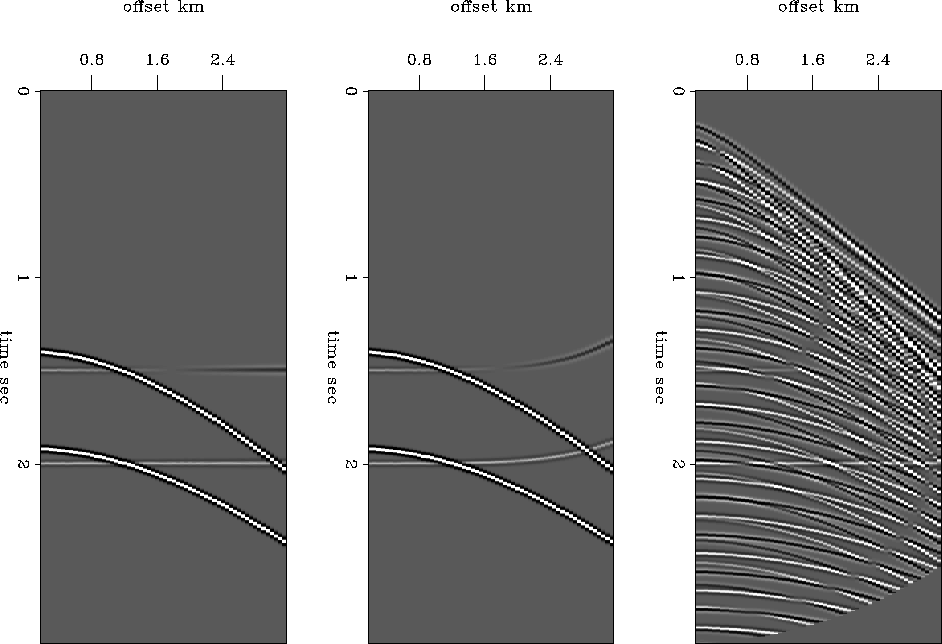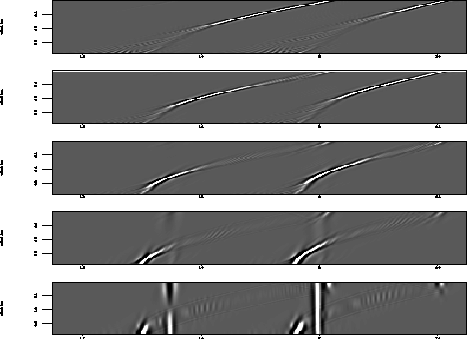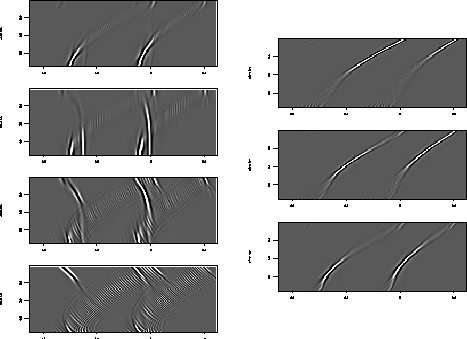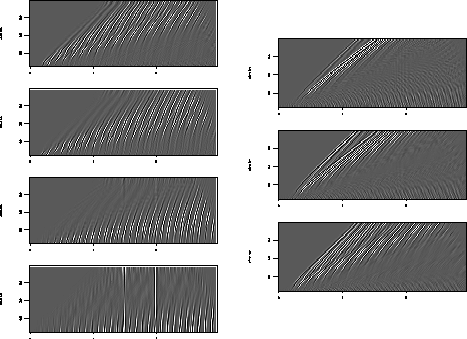| |
(6) |
 |
I applied the inversion to the synthetic data displayed in
figure ![[*]](http://sepwww.stanford.edu/latex2html/cross_ref_motif.gif) after applying NMO.
The NMO-corrected synthetic data is displayed in figure
after applying NMO.
The NMO-corrected synthetic data is displayed in figure ![[*]](http://sepwww.stanford.edu/latex2html/cross_ref_motif.gif) . The
application of NMO has the effect of limiting the dip range in the
data. This reduces the size of the model space necessary to represent
the input data.
. The
application of NMO has the effect of limiting the dip range in the
data. This reduces the size of the model space necessary to represent
the input data.
The inversion results for the NMO-corrected data
appear in figures ![[*]](http://sepwww.stanford.edu/latex2html/cross_ref_motif.gif) ,
,![[*]](http://sepwww.stanford.edu/latex2html/cross_ref_motif.gif) +
+ ![[*]](http://sepwww.stanford.edu/latex2html/cross_ref_motif.gif) .
Each figure displays all the slowness slices from the model space of
the beam stack inversion. It
is apparent from figures
.
Each figure displays all the slowness slices from the model space of
the beam stack inversion. It
is apparent from figures ![[*]](http://sepwww.stanford.edu/latex2html/cross_ref_motif.gif) +
+![[*]](http://sepwww.stanford.edu/latex2html/cross_ref_motif.gif) that the
primary energy is confined to the zero slowness slice of the model
space, while figure
that the
primary energy is confined to the zero slowness slice of the model
space, while figure ![[*]](http://sepwww.stanford.edu/latex2html/cross_ref_motif.gif) shows that the primary energy
resides in zero and negative slowness slices.
shows that the primary energy
resides in zero and negative slowness slices.
 |
 |
 |
I forward modeled each inversion result to produce a reconstruction of
the NMO-corrected synthetic data. The difference in total energy
between the reconstructed synthetic data and original synthetic data
is less than ![]() in each case. This difference was achieved
in five iterations and required three minutes of computing time on one
processor of an SGI power challenge.
in each case. This difference was achieved
in five iterations and required three minutes of computing time on one
processor of an SGI power challenge.
An alternative to the iterative least-squares solution is a
direct inversion. To implement the direct inversion, the
data covariance matrix, ![]() , must be inverted. This matrix, and
the beam stack operator itself, can be
partitioned into a separate matrix for each frequency of interest, thus
reducing the size of the data covariance matrix significantly.
The partitioned beam stack operator in matrix form is of size
(Nx)(NxNp) while the partitioned data covariance matrix is of size
(Nx)(Nx). In order to apply a direct least
squares inversion, the data covariance matrix would have to be
inverted for each frequency of interest and applied as a
pre-conditioner to the application of the adjoint to the data.
, must be inverted. This matrix, and
the beam stack operator itself, can be
partitioned into a separate matrix for each frequency of interest, thus
reducing the size of the data covariance matrix significantly.
The partitioned beam stack operator in matrix form is of size
(Nx)(NxNp) while the partitioned data covariance matrix is of size
(Nx)(Nx). In order to apply a direct least
squares inversion, the data covariance matrix would have to be
inverted for each frequency of interest and applied as a
pre-conditioner to the application of the adjoint to the data.
Hampson (1986) used this approach to formulate the
direct least squares inverse of the parabolic radon transform. In the
case of the radon transform, the model covariance matrix must be inverted.
The model covariance matrix of the PRT is of size
(Np)(Np) where p is the slowness parameter of the PRT. A
typical range of the PRT parameter p is 50.
Kostov (1990) has shown that the family of radon transforms
results in a model covariance matrix that is Toeplitz in
structure and as such
can be inverted with the Levinson method (and other methods) at a cost
proportional to n2 instead of n3, where n is the size of the
matrix to be inverted Claerbout (1976). The Toeplitz property
of the PRT model covariance matrix coupled with its reasonable size,
around, ![]() , elements, make a direct inversion of the PRT model covariance matrix reasonable.
The parabolic beam stack data covariance matrix is not Toeplitz and it's size
is equal to the square of the number of offsets in the data. Because of these features, the parabolic beam stack operator is not a great candidate for a direct inversion.
, elements, make a direct inversion of the PRT model covariance matrix reasonable.
The parabolic beam stack data covariance matrix is not Toeplitz and it's size
is equal to the square of the number of offsets in the data. Because of these features, the parabolic beam stack operator is not a great candidate for a direct inversion.